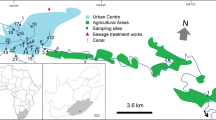Abstract
Stormwater ponds are an increasingly common feature in urban landscapes. Because these ponds retain runoff and particulate-bound contaminants from impervious surfaces, organisms inhabiting stormwater ponds may be exposed to elevated metal levels in sediments. This study evaluated temporal changes in sediment and macroinvertebrate Cu, Pb and Zn over an eleven-year period with specific attention to land use in pond watersheds. Sediment and invertebrate metal levels were quantified using atomic absorption spectrophotometry (1993 samples) or inductively coupled plasma mass spectrometry (2003–2004 samples). Sediment trace element levels did not significantly change from 1993 to 2003-2004 with the exception of Zn in ponds receiving runoff from highways, which increased from a mean of 32 mg kg−1 in 1993 to 344 mg kg−1 in 2003–2004. Sediment Pb and Cu generally remained below published threshold effects concentrations (TEC) except for two instances of elevated Cu in 2003–2004. Zn remained below the TEC in 1993 but exceeded the TEC in six ponds in 2003–2004. Trace metal body burdens varied among invertebrate groups, and to a lesser extent among land uses, but in both cases this variation was a function of year. In general, trace element body burdens were more similar among invertebrate groups or land use or both during 2003–2004 when compared to levels in 1993. Our results suggest sediment and invertebrate trace metal levels are at steady state in these stormwater management ponds and that risk to organisms inhabiting these ponds does not vary as a function of pond age.
Similar content being viewed by others

References
Bishop, C.A., Struger, J., Shirose, L.J., Dunn, L., & Campbell, G.D. (2000). Contamination and wildlife communities in stormwater detention ponds in Guelph and the Greater Toronto Area, Ontario, 1997 and 1998. Part II—Contamination and biological effects of contamination. Water Quality Research Journal of Canada, 35, 437–474.
Casey, R.E., Shaw, A.N., Massal, L.R., & Snodgrass, J.W. (2005). Multimedia evaluation of trace metal distribution within stormwater retention ponds in suburban Maryland, USA. Bulletin of Environment Contamination and Toxicology, 74, 273–280.
Councell, T.B., Duckenfield, K.U., Landa, E.R., & Callender, E. (2004). Tire-wear particles as a source of zinc to the environment. Environmental Science and Technology, 38, 4206–4214.
Datry, T., Malard, F., Vitry, L., Hervant, F., & Gilbert, J. (2003). Solute dynamics in the bed sediments of a stormwater infiltration basin. Journal of Hydraulic, 273, 217–233.
Davis, A.P., Shokouhian, M., & Ni, S. (2001). Loading estimates of lead, copper, cadmium and zinc in urban runoff from specific sources. Chemosphere, 44, 997–1009.
Durand, C., Ruban, V., & Ambles, A. (2004). Mobility of trace metals in retention pond sediments. Environmental Technology, 25, 881–888.
Greenstein, D., Tiefenthaler, L., & Bay, S. (2004). Toxicity of parking lot runoff after application of simulated rainfall. Archives of Environment Contamination and Toxicology, 47, 199–206.
Hares, R.J., & Ward, N.I. (2004). Sediment accumulation in newly constructed vegetative treatment facilities along a new major road. Science of the Total Environment, 334, 473–479.
Hur, J., Schlautman, M.A., & Yim, S. (2004). Effects of organic ligands and pH on the leaching of copper from brake wear debris in model environmental solutions. Journal of Environmental Monitoring, 6, 89–94.
Karouna-Renier, N.K., & Sparling, D.W. (2001). Relationships between ambient geochemistry, watershed land-use and trace metal concentrations in aquatic invertebrates living in stormwater treatment ponds. Environmental Pollution, 112, 183–192.
Liebens, J. (2001). Heavy metal contamination of sediments in stormwater management systems: the effect of land use, particle size and age. Environmental Geology, 41, 341– 351.
MacDonald, D.D., Ingersoll, C.G., & Berger, T.A. (2000). Development and evaluation of consensus-based sediment quality guidelines for freshwater ecosystems. Archives of Environment Contamination and Toxicology, 39, 20–31.
Nightingale, H.I. (1987). Accumulation of As, Ni, Cu, and Pb in retention and recharge basins soils from urban runoff. Water Resources Bulletin, 23, 663–672.
Pitt, R., Clark, S., & Field, R. (1999). Groundwater contamination potential from stormwater infiltration practices. Urban Water, 1, 217–236.
Rainbow, P.S. (2002). Trace metal concentrations in aquatic invertebrates: why and so what? Environmental Pollution, 120, 497–507.
Simon, J.A. (2006). Relationships among urban land cover, trace metal bioaccumulation and habitat value of stormwater management ponds. MS Thesis, Towson University.
Stahre, P., & Urbonas, B. (1990). Stormwater Detention: For Drainage, Water Quality, and CSO Management. Englewood Cliffs, NJ: Prentice Hall.
USEPA. (1999). Preliminary data summary of urban storm water best management practices. EPA-821-R-99-012, Office of Water, Washington, DC.
Van Metre, P.C., & Mahler, B.J. (2003). The contribution of particles washed from rooftops to contaminant loading to urban streams. Chemosphere, 52, 1727–1741.
Yap, C.K., Ismail, A., Tan, S.G., & Omar, T. (2003). Accumulation, depuration and distribution of cadmium and zinc in the green-lipped mussel Perna viridis (Linnaeus) under laboratory conditions. Hydrobiologia, 498, 151–160.
Yu, R.-Q., & Wang, W.-X. (2002). Kinetic uptake of bioavailable cadmium, selenium and zinc by Daphnia magna. Environmental Toxicology and Chemistry, 21, 2348–2355.
Author information
Authors and Affiliations
Rights and permissions
About this article
Cite this article
Casey, R.E., Simon, J.A., Atueyi, S. et al. Temporal Trends of Trace Metals in Sediment and Invertebrates from Stormwater Management Ponds. Water Air Soil Pollut 178, 69–77 (2007). https://doi.org/10.1007/s11270-006-9132-z
Received:
Accepted:
Published:
Issue Date:
DOI: https://doi.org/10.1007/s11270-006-9132-z



